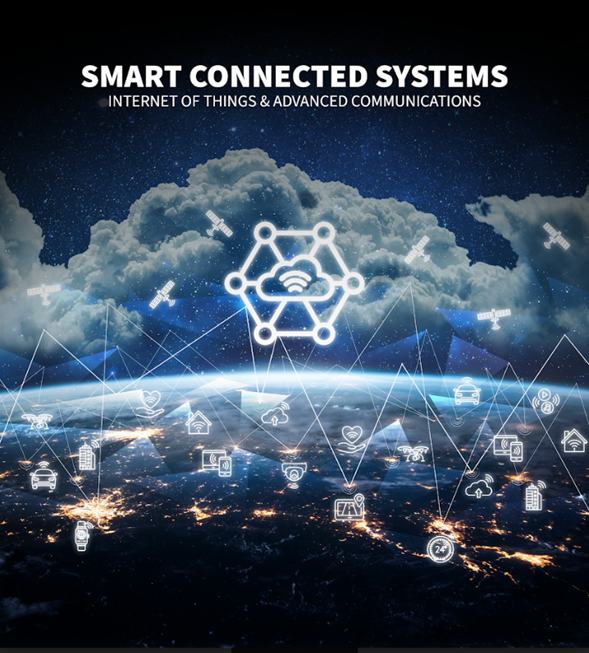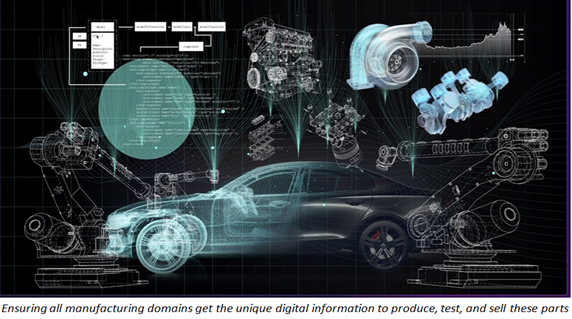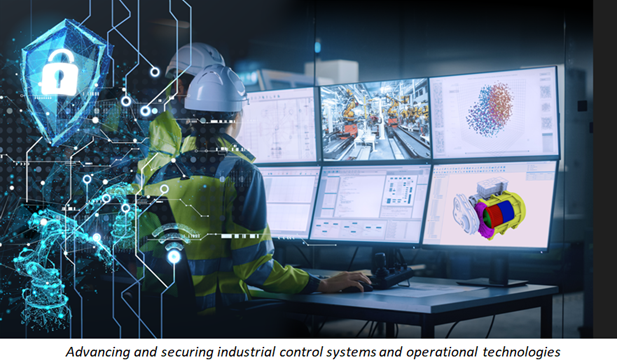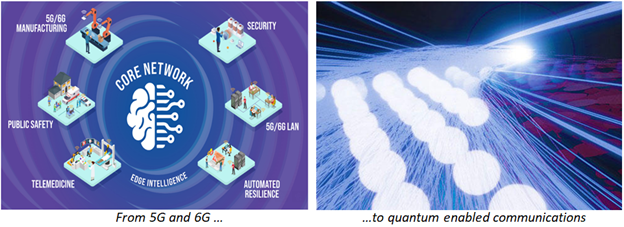NIST Smart Connected Systems Newsletter
2022 in Review

Since its creation this past year, the Smart Connected Systems Division in the NIST Communications Technology Laboratory has worked with partners to advance measurement science, standards, guidance, and test methods to support advanced communications networks, trustworthy IoT systems, and critical applications areas.
As we start a new year, our Smart Connected Systems Division leadership team, staff, and associates collectively thank our many industrial, government, and academic stakeholders. You have helped us advance innovation, competitiveness, and improvements in quality of life provided by these systems. We look forward to continuing collaborations, interactions, and additional outreach to identify and develop new partnership opportunities.
Smart connected systems bring together the logical (cyber) and physical worlds, and with computing, they can sense and respond to changing environments. And these systems portend future innovations different from what we already know – with profound changes for how we will work and live.
Such potential is seen in the Smart Connected Systems Division's areas of research – automated vehicles, smart cities, smart manufacturing, smart grid, operational technologies, and transformative networks. But the possibilities for smart connected systems are just emerging and limited only by our imagination. They offer ways to address many of the challenges we face at the societal, national, and global levels.
In 2022, the Division focused on improving, securing, and expanding the connectivity of smart systems – and always with an eye on future directions, stakeholder goals, and how smart connected systems can provide equitable and inclusive benefits. In the following, we share some of our advances over the past year, and we thank you for giving us two precious commodities – your attention and time. Best wishes for 2023!
Abdella Battou, Division Chief, and
David Wollman, Deputy Division Chief
Back to Top
 IoT Devices and Infrastructure Group: Addresses the development and engineering of the Internet of Things for such applications as automated vehicles, smart cities and communities, and more. The Group's advances in 2022 include the following:
Simulating Complex Cyber-Physical Systems (CPS): These are massive systems that contain many communicating parts including small IoT devices, physical infrastructure, and humans. Simulation is key to determine if a complex CPS will work as intended – and the subject of Integrating Multiple HLA Federations for Effective Simulation-Based Evaluations of CPS. It offers ways to develop multiple simulation federations for testing a complex CPS. The publication focuses on modeling a manufacturing plant as a use case, which is aided by NIST's Universal CPS Environment for Federation. (See University, NIST Researchers Offer Ways to Simulate Complex Cyber-Physical Systems, September 2022 newsletter)
Holistic Key Performance Indicators for Developing Smart Communities: These metrics are found in NIST Special Publication 1900-206 Smart Cities and Communities: A Key Performance Indicators Framework. The publication provides a structured representation of smart community information flows. Its methodology can help align KPIs and investments with community priorities, and help assess investment efficiency, information flow density, and quality of services and community benefits. (See NIST International Collaboration Develops New Framework for Smart Cities and Communities, NIST Updates, February 28, 2022)
Diversity, Equity, Integrity, and Technology SuperCluster Informing Smart Community Development: This new working group is part of the NIST Global City Teams Challenge. The group includes representatives from across the country and research teams to help assess key performance indicators for ethics, equity, and integrity in smart cities development. The group is also assessing a potential technology review board methodology, complemented by community engagement. (See NIST's Global City Teams Challenge Establishes Diversity, Equity, Integrity, and Technology SuperCluster, May 2022 newsletter)
Online Tool for Quantifying Automated Driving Conditions: Called the "Operational Design Domain Element Quantification Prototype," the tool was developed by our partner VTTI with NIST support. The tool helps researchers and industry practitioners quantify automated driving conditions in a city, community, or region. These driving conditions serve as elements in automated vehicle design and testing, termed Operational Design Domain (ODD). The tool provides users with access to design elements in 30 major U.S. cities, such as weather, routes, crash data, and more. (See VTTI, NIST Provide Tool for Quantifying Automated Driving Conditions, NIST Updates, February 16, 2022)
Technical Foundations for Measuring Automated Driving System Safety: Called the "Operating Envelope Specification (OES)," this framework was developed by NIST researchers in consultation with auto industry experts and safety regulators. The framework provides the foundations for measuring automated vehicle performance, including its safety systems. The OES extends the Operational Design Domain, includes measurement methods for each of its elements, and supports automated vehicle performance assessments by researchers and industry practitioners. This framework for operating condition measurement informs automated vehicle design as well as testing, whether by researchers, developers, or performance regulators. (See Technical Foundations for Smart Connected Systems, April 17, 2022 and Automated Driving System Safety Measurement Part I: Operating Envelope Specification)
Stakeholder Collaboration on the Way Ahead for Automated Vehicles: Stakeholder input was a key part of a NIST-sponsored workshop on automated vehicles, with nearly 800 attendees from industry, academia, and government. Attendees discussed the need for standards, test methods, and performance metrics for automated vehicles. They also addressed key areas related to automated vehicle development: safety, communications, artificial intelligence, cybersecurity and privacy. NIST has published a report on the workshop and has funded an exploratory NIST-wide effort to advance measurements for automated vehicles. (See Stakeholders Provide Input on Automated Vehicle Performance Metrics in NIST Workshop, March 2022 newsletter)
Back to Top
 Smart Connected Manufacturing Systems Group: Promotes fully integrated, collaborative manufacturing that can readily respond to changing demands and factory conditions. The Group's 2022 advances include the following:
Proposed Upgrade to Systems Modeling Language: Many manufacturers specify requirements for complex systems, as well as designs and tests for them, using the Systems Modeling Language (SysML 2). NIST and the Object Management Group have continually advanced SysML 2. This past year, NIST offered major upgrades, enabling SysML 2 to model required spatial relationships – such as landing gear being inside a plane after takeoff – without committing to detailed object geometry, leaving that to alternative design exploration and evaluation. The updates were accepted in a draft specification submitted to OMG. (See NIST Researcher Proposes Modeling Language Upgrade to OMG Standards Organization, August 2022 newsletter)
Developing Digital Data Defenses for Manufacturing: Digital representation is making manufacturing faster and more efficient, but it also faces digital threats, which seek to maliciously change designs and corrupt files. Most U.S. manufacturers are small and lack resources to build digital defenses. Working with stakeholders, NIST is developing a web-based application called "EasyTrust," which will help small manufactures implement solutions for countering and mitigating digital threats. (See NIST Researcher Describes 'EasyTrust' for Digital Data Defense in Manufacturing, August 2022 newsletter)
Modeling the Manufacturing of Finished Products: In 2022, NIST researchers released the simulation software called, “Simulated-Production Resource for Operations and Conditions Evaluation to Support Decision-Making,” or Sim-PROCESD. It focuses on asynchronous production, which moves jobs to workstations when they are available. The simulation also can model the degradation and maintenance of machines involved. The simulation has garnered interest in academia and other government agencies. (See NIST Manufacturing Simulation Software Gets Interest from University and Government, December 2022 newsletter)
Evaluating Condition Monitoring Systems: These systems monitor production lines and machines for detrimental changes so that costly problems can be mitigated. Yet, some are hesitant to adopt them because of their uncertain return on investment. To help evaluate them, NIST published Key Elements to Contextualize AI-Driven Condition Monitoring Systems towards Their Risk-Based Evaluation. The publication provides an evaluation process that captures the impact of condition monitoring systems. (See Are Condition Monitoring Systems Worth It? NIST Researchers Offer Way to Evaluate, December 2022 newsletter)
Facilitating a Standard That Allows Key Production Systems to Operate off the “Same Sheet of Music:” In manufacturing, the “digital thread” means that information flows across the enterprise so all involved can contribute to a finished product. The problem is that different participants need different information. NIST is helping ISO to further develop the "Standard for the Exchange of Product Data." New capabilities in the standard, such as semantic representation of manufacturing requirements, will enable more varied systems to get the needed information for their respective functions. (See NIST Leader Helps Develop ISO Standard Enabling Production Systems to Read Unique Data, December 2022 newsletter)
Back to Top
 Networked Control Systems Group: Researches and advances sensor networks and system controls for use in manufacturing, industrial environments, construction, and mission critical applications. The Group's 2022 advances in these areas include the following:
Cybersecurity Guide for Manufacturing Control Systems: This guide addresses the growing cyber threat to this sector, and is available as NIST Special Publication 1800-10 Protecting Information and System Integrity in Industrial Control System Environments: Cybersecurity for the Manufacturing Sector. Its purpose is to protect systems which help manage machinery, production lines, and other physical processes that produce goods. The guide provides solutions which are mapped to NIST Cybersecurity Framework. (See NIST Releases Cybersecurity Guide for Manufacturing Control Systems, NIST Updates, March 1, 2022)
Draft Guide on Operational Technology Security: This draft NIST Special Publication (SP) 800-82r3 was released for stakeholder input. It is intended to improve the security of operational technologies which detect changes in industrial, building automation, transportation, and other similar systems. The draft provides an overview of operational technologies; identifies threats to them; describes their vulnerabilities; and recommends security safeguards and countermeasures for managing risks. (See NIST Seeks Inputs on its Draft Guide on Operational Technology Security, May 2022 newsletter)
Study on Blockchain and Related Tech for Manufacturing Supply Chain Traceability: Manufacturing supply chains are susceptible to disruptions and sabotage. To help industry, NIST published NIST Internal Report 8419, Blockchain and Related Technologies to Support Manufacturing Supply Chain Traceability: Needs and Industry Perspectives. It explains how tamper-evident and tamper-resistant information sharing technologies, like blockchain, can assure traceability of products in a supply chain. (See NIST Releases Study on Blockchain and Related Technologies for Manufacturing Supply Chain Traceability, May 2022 newsletter)
Exploring the Potential Use of Industrial Wireless Technologies: Conceivably, these could help make manufacturing faster, better, and cheaper. NIST researchers are exploring this potential and reporting findings in publications. They have assessed millimeter-wave, wireless technologies in a highly reflective, factory-like environment. They have also assessed time-synchronized, wireless time-sensitive networking for coordinated use of robotic arms, to include lifting heavy objects. (See NIST Researchers Publish on Machine Learning to Assess Industrial Wireless Technologies, September 2022 newsletter)
Wireless Time-Sensitive Networking for Industrial Applications: NIST and Intel Labs researchers used wireless time-sensitive networking to coordinate two Universal robotic arms, simultaneously lifting a force/torque sensing bar. The experiments showed a reduced impact from co-channel interference traffic, which normally cause increased jitter and latency spikes for a Wi-Fi link, not using scheduling for wireless time-sensitive networking. The research was presented at the IECON 2022 Conference in Brussels, Belgium and showed the advantages of wireless time-sensitive networking in this use case. Future work seeks to influence future wireless standards, aiding deployment, configuration, and enhanced flexibility of wireless time-sensitive networking. (See Overview of NIST Work on Industrial Time-Sensitive Networking Presented at IECON 2022, December 2022 newsletter)
Facilitating a Standard for Assessing Industrial Wireless Technologies: Working with key international industry and academic partners, NIST staff are chairing and supporting the IEEE P1451.5p Working Group, which is defining a process for evaluating industrial wireless communications systems' performance. Specifically, the standard will help researchers identify factors impacting industrial wireless performance; give recommendations for setting up and conducting tests; and provide profiles for different industrial scenarios and applications. (See At Conference, NIST Researcher Previews Forthcoming Standard for Assessing Industrial Wireless, December 2022 newsletter)
Back to Top
The Smart Grid Group advances the interoperability, reliability, and optimization of a rapidly transforming power grid, with its increasing use of renewable energy systems, sensors, and microgrids. The Group's 2022 advances include the following:
Proposed Integration of Electric Vehicle Charging Stations and Power Grid: This is addressed in the Interoperability Profile for Electric Vehicle Fleet Managed Charging. The Profile describes the needed functions and interactions between charging stations and the grid. The Profile lays out the technical requirements for their information exchanges, which are based on the smart grid communication protocol IEEE 2030.5-2018. NIST developed the Profile with the Smart Electric Power Alliance. (See NIST, SEPA Develop Interoperability Profile for Integrating Electric Vehicle Charging with Grid, July 2022 newsletter)
Proposed Integration of Distributed Energy Resources (DER) and Power Grid: This is addressed in IEC 61850 Profile for Distributed Energy Resources Supporting IEEE 1547. NIST researchers and stakeholders narrowly focused on two existing standards –IEC 61850 and IEEE 1547 – and mapped a way to achieve interoperability between DER and the grid. The Profile's implementation also could reduce the complexity of meeting these standards and improve testing and certification. (See NIST Develops Interoperability Profile for Distributed Energy Resources and Grid Integration, July 2022 newsletter)
Helping Industry Test Interoperability between Grid and Renewables: NIST provided testing expertise to the OpenFMB PlugFest 2.0, sponsored by the Utility Communications Architecture International User’s Group. The plugfest sought to validate the interoperability of vendors' distributed energy resources with the grid. NIST staff served as the official third-party technical observer and evaluated the standard's implementation towards testing accreditation, per the ISO/IEC 17025 standard. (See NIST Researcher Helps Industry with Testing Interoperability between Grid and Renewables, November 2022 newsletter)
Communicating a Vision for Grid Interoperability and its Benefits: This vision is communicated through podcasts and journal articles. These communications have helped advance grid interoperability and made known its ever-evolving benefits, to include reduced installation costs; increased use of renewables; enabling disparate devices to communicate with operators to help balance the grid; and providing greater grid awareness. Additionally, these communications have made known ways to improve interoperability. (As an example, see NIST Leader, Researcher Explain Benefits of Smart Grid Interoperability and How to Achieve It, July 2022 newsletter)
NIST Smart Grid Framework 4.0 Use in Analysis of Southeast Asian Grid Standards: NIST staff helped the Department of Commerce International Trade Administration with its assessment, Smart grid Standards Adoption in Southeast Asia. The assessment used the NIST Framework and Roadmap for Smart Grid Interoperability Standards, Release 4.0 in a gap analysis of existing standards in the region. The assessment noted, "The Framework provides a useful conceptual model for smart grid applications." (See NIST Smart Grid Framework 4.0 Aids Gap Analysis of Southeast Asian Grid Standards, NIST Updates, February 1, 2022)
Back to Top
 Transformational Networks and Services Group: Researches quantum communications, cloud computing, wireless sensor networks, 5G, 6G, information centric networking, and their potential impacts on how we will work and live. The Group's 2022 advances include the following:
Demonstrating the Potential of Quantum-Enabled Communications: Quantum portends huge advances for communications. Relative to classical communications, quantum communications have shown greater message accuracy, as reported in a conference publication, and which could help address the Internet's approaching "capacity crunch." The Group also reported achieving distant quantum entanglement of protons, conceivably enabling new cryptography. (As an example, see NIST Researchers Demonstrate Quantum Entanglement with Distant, Synchronized Network Nodes, August 2022 newsletter)
Deployment of High Speed NDN Router on NSF-funded Testbed: The Group developed this high-speed networking router which seeks and fetches at speeds higher than 100 gigabit per second. Called the "Named Data Networking-Data Plane Development Kit (NDN-DPDK)," the NDN router was developed to help address the need for better performance in future Internet architectures. The router will deploy on a National Science Foundation-funded testbed, which researches networking. (See NSF-funded Testbed to Deploy NIST's NDN Router Allowing Users to Find and Get Data at High Speeds, November 2022 newsletter)
Algorithm Developed for Assuring 5G/6G Networks Quality-of-Service: These networks will differ from one-size-fits-all 4G networks; 5G/6G networks will support automated manufacturing, vehicle-to-vehicle communications, and drones – each sensitive to data delays. The Group developed and demonstrated an algorithm that allows networks to negotiate needed data with systems. The algorithm was reported in End-to-End Quality-of-Service Assurance with Autonomous Systems: 5G/6G Case Study. See NIST Researchers Develop Algorithm for Assuring Quality-of-Service in 5G/6G Networks, NIST Updates, February 19, 2022)
International Development of 5G and Cloud Computing Federation Testbeds: International researchers, including those at NIST, are pursuing testbeds that use 5G to access federated cloud computing – multiple computing clouds. Compared to today, 5G will give developers faster and greater access to more data sources, which is expected to lead to new innovations. Also, these linked testbeds will allow remote use of each others' technologies, enabling even more innovations. (See International Researchers Pursue 5G Testbed, July 2022 newsletter)
A Path to a Cloud Computing Federation via Standards: This path was described in an IEEE webinar and IEEE publication. The goal is a standards-based federation, with multiple clouds, allowing users to access all cloud services, but with providers still controlling what they find. The path would involve NIST and IEEE collaborating on a cloud federation standards. A public working group also might develop a federation vocabulary and concept. These outputs would aid an IEEE working group's development of a standard. (See NIST, Industry Researchers Use IEEE Standard to Point a Way Ahead for Cloud Computing, September 2022 Newsletter)
Back to Top
|